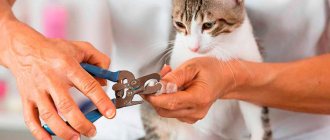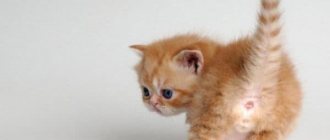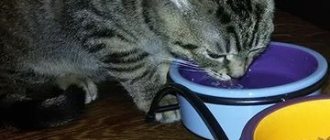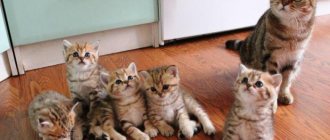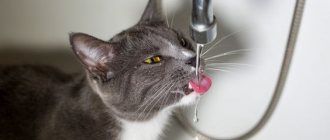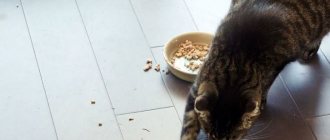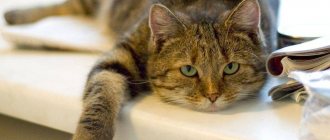Reasons why a cat doesn't drink water
Of course, water is essential for the health of our cat and should be consumed daily in sufficient quantities, but this does not always happen. Naturally, cats do not drink because they are accustomed to consuming the necessary liquid directly from their prey, which is usually rodents, birds and even lizards with a water content of about 70%. But cats that live indoors do not have the opportunity to hunt and depend on food provided by their owners. I think this is very common with around 8% water content as a result of the manufacturing process.
© shutterstock
Comparing natural prey with this menu, we will understand that the cat must swallow liquids in much larger quantities than she is used to. Consequently, health problems may arise and it is important that we encourage our cat to drink. Therefore, it is normal for us to worry if we notice that our cat is not drinking water. In this sense, one of the most common reasons is that the cat hunts and feeds if it has access from outside. If not, then the reasons may be:
- The cat doesn't like her drinking fountain. In this case, the cat can drink water from other sources, such as a tap.
- The drinking fountain is located too close to the tray. Cats are animals that prefer their space to be well-partitioned, so they may refuse to drink water if their drinking fountain is too close to an area intended for relief.
- Their diet is wet and they already meet their water needs.
- The water is dirty and the cat prefers not to drink. These animals are also known for their neatness, so they refuse to drink water that they consider bad.
- There are several cats, and one or more are preventing the others from drinking water. If your cat has stopped drinking water and you recently adopted another cat, she may be using her resources.
- The cat has a medical condition that causes him to drink less water.
Since he may have health problems, it is important to go to the vet for a checkup. If this reason is excluded, how to teach a cat to drink water? How much water does a cat need to drink per day? In the following sections, we explain what steps we can take to get your cat to drink more, how much water to drink, and what to do if she doesn't drink enough water.
The main reasons for refusing water
Possible reasons for a cat refusing water may be:
- the cat receives all the necessary volume of liquid with wet food;
- the cat found a source of drinking in another place unknown to you in the apartment or on the street, for example, in the bathroom or in a puddle while walking;
- contaminated water that has a foreign odor or taste;
- The water container is dirty or has a strong foreign odor;
- change of water source;
- the water is very cold;
- high water hardness;
- proximity of the water container to the toilet;
- change of environment (moving to another home or to another area);
- increase in humidity and (or) decrease in room temperature;
- animal disease;
- mechanical obstructions (such as a stuck bone) or trauma in the mouth;
- postoperative period.
In any case, a cat’s refusal to drink water for 2 days is a good reason to contact a specialist for examination and testing.
Benefits of water for cats
Good hydration promotes proper functioning of the kidneys and urinary system. In addition, it prevents the formation of crystals as it increases the dilution of urine and if you go to the sandbox more times, it remains in the bladder less time, which is another factor that contributes to sedimentation.
If water intake is important for healthy cats of any age, it is even more important for those with urinary or kidney problems. In these cases, you should not only follow the advice outlined in the following sections, but also take the cat into the hands of a veterinarian.
What kind of water should I drink?
To avoid health problems, it is not enough for an animal to consume a certain amount of liquid per day. Another important condition is that the water must be of high quality, which is why the owner needs to be very careful about its choice. For an animal to like water, it must be:
- fresh and clean (it is recommended to change the water every day);
- do not contain foreign odors;
- should be freely available.
If owners give their pet water from the tap, before pouring it into a bowl, the liquid must be filtered and allowed to steep for at least 5 hours. However, veterinarians categorically do not recommend using it, since running water contains many harmful impurities and components, including chlorine.
How to offer water to a cat?
When it comes to drinking, cats can be something special. The first step to getting your cat to drink water is, of course, to make sure she has clean, fresh water available 24 hours a day, and it should be changed several times a day. It is recommended to leave several drinking bowls in different parts of the house so that you always have quick access to them. In addition, if there is more than one cat in the house, it is good that they have their own bowls so that everyone can drink in peace without preventing others from accessing this resource.
On the other hand, cats like to distribute their home into different spaces. This means keeping the water separate from the litter box, play area, bed, or other resting surfaces. It is also not good that it is attached to the feeder. In addition, it is necessary to choose a suitable drinking bowl. Sometimes we may notice that our cat does not drink water from the bowl because it is too closed, so that its whiskers rub against the edges, which creates discomfort. Therefore, you should choose wide gutters in which this contact does not occur. The material is also important. Plastic can change over time, so it is recommended to choose stainless steel or ceramic, which are also easy to clean.
Fountains for cats
Sources for cats deserve a separate section. Many of them instinctively reject stagnant water, and we will sometimes see them put their foot in the drinking bowl to move it before they start drinking. Others jump into the tap water as soon as they realize we're opening it, or even open it themselves.
In these cases, cat fountains are a good option because they keep the water moving continuously, which encourages them to drink.
As a recommendation, leave her drinking fountain running at first until she adjusts to using the new fountain.
© shutterstock
How to teach a kitten to drink?
There are many ways to teach a kitten to drink water from a bowl. The easiest way to do this is during an active pastime. During the game, the pet moves a lot and loses more moisture than in a calm state. Immediately after the game, the owner needs to bring a bowl to his face, so the chance of teaching the animal to drink cool water increases several times.
If the animal still refuses to drink, it can be forced to do so, for example, using a syringe filled with water. In addition, a small amount of liquid can be added to your pet's food so that he consumes it along with food. If the cat is very small, you can teach him to drink in the following ways:
- You can add a little milk to the food and gradually mix it with water. Kittens know what milk smells like and therefore rarely refuse it.
- You can place several bowls filled with clean water throughout the apartment. They should attract the kitten's attention, so it will be much easier to teach him to drink.
- Another effective way to teach a kitten to drink is by wetting its nose in water or milk. The owner just needs to wet his finger in water and wipe the animal’s nose with it several times. The cat will lick it by inertia, thereby getting used to the smell and taste of water.
Diet with lots of water
If you feed your cat food, it is likely that although she will drink, she will not do so in sufficient quantities to meet her needs. This is why it is recommended to at least offer him a so-called mixed diet, which is nothing more than feeding and wet food, which is canned cat food. So, if you are wondering how to hydrate a cat that doesn't want to drink water, this type of diet has the answer.
Thus, we must calculate the amount of dry food and wet food that our cat needs daily and offer her, for example, half of each diet to create her menu. It's important to take the time to calculate otherwise if we overdo it we risk causing weight gain.
Both products should be given separately and it is recommended to offer them in small quantities several times a day. This is a feeding method that is closer to its natural behavior, and it has also been proven that eating more frequently encourages a cat to drink more times.
On the other hand, remember to choose a quality diet. Spend some time comparing the formulations and ingredients of different brands. There are good options for every budget. It is important that the food you choose is tailored to your cat's stage of life, and if she has any medical conditions, you provide her with a special diet prescribed by your veterinarian for both dry and wet food. Otherwise, the desired positive effects would not be achieved.
Finally, you can feed your cat homemade food if the menu is designed by a cat nutrition expert. Otherwise, nutritional deficiencies and health problems may result.
Sphinx food.
A cat needs a lot of protein. In cats, the intestines are structured differently and some “human” food remains simply rot inside, which is the cause of many diseases. Ideally, the ratio of protein to carbohydrates should be 2:1. And it should also be taken into account that pebbles require more calories, because... they warm themselves.
products containing protein in descending order: beef; dairy products; wheat; egg; chicken; lamb; soy; corn; pork (although any veterinarian will tell you that no animal should eat pork); rice; fish.
Feeding a small Sphynx: they begin to give water constantly from 2.5-3 months (younger kittens usually do not drink water). Milk is food and should not be used instead of water. A one-month-old kitten is given approximately one tablespoon of food per feeding. The frequency of meals for a one-month-old kitten is 4-5 times and by 6 months it is reduced to 1-2 (in practice this is not realistic. Ours is already a year and a half old and he eats at least 3-4 times a day, but in small quantities). Any Sphynx (I would say any domestic animal) has a good appetite and is easy to overfeed, especially at a young age. he will become obese and it doesn’t look as charming as those of his furry brothers, believe me, I saw one of these at an exhibition. So, don’t spoil him with sweets and fatty foods, especially since this is harmful to the liver - it is very vulnerable in all cats , as well as the urogenital system.
What to do if your cat doesn't drink water?
If you offer your cat a diet with a good supply of water, it is likely that you will find that she does not drink much, but her needs will generally be covered. On the other hand, if the cat is only eating, I think, and although you followed the previous advice, you may be sick and dehydrated. Check this by gently pulling the skin at the withers. If it takes time to return to its original position, it indicates dehydration and we should contact a veterinarian. Also if we detect other symptoms or if the cat is still not drinking.
Likewise, instead of wondering why your cat isn't drinking water, make an appointment with your veterinarian. Kittens and older cats are especially susceptible to dehydration, and their condition may worsen within a few hours. Therefore, in any case, if your cat has stopped drinking water, you should call the vet, regardless of whether it happens from day to day or you notice that he is drinking less. In addition, on the contrary, drinking a lot of water is also a symptom of the disease.
Article Author: Catit - Animal Expert We are cat lovers. Catit has been combining a passion for cats with innovation in products designed specifically for them for many years. They say a house with cats is a house with magic, and we couldn't agree more. Our goal as cat product manufacturers has always been to create completely effective and 100% engineered and engineered designs for our cats. Catit not only meets all your needs, but also offers unique features that provide great value.
Symptomatic treatment
When the breeder notices that the cat has become lethargic, she practically does not drink, urination becomes rare, and the litter box smells too bad after each visit, there is no time to hesitate. The faster the animal receives qualified help, the faster the recovery will come.
If there are clear signs of dehydration, such as diarrhea or uncontrollable vomiting, veterinarians will first replace lost fluids and then begin treatment.
If an animal is sick, it may be given glucose injections and saline infusions. Moreover, this is not treatment, but only maintaining the homeostasis of the animal. Treatment of the underlying disease must be carried out without fail. If a cat does not drink, this is a serious sign; without qualified help, the pet may die.
For example, with severe diarrhea, hours can count. Symptoms of dehydration develop quickly. When fluid balance is restored, veterinarians prescribe antibiotic therapy.
If a cat develops a tumor, the prognosis is, unfortunately, unfavorable. There are no effective treatments for cancer of the tongue and oral cavity. The only treatment that the clinic can offer is tongue removal. In this case, the doctor removes a stoma (makes a special hole), through which the cat needs to be watered and fed.
Liquid consumption rate
When feeding an animal with dry food, it is necessary to provide it with constant access to clean water. On average, a cat should drink about 100-150 ml per day, depending on the weight of the pet. Particularly obese cats need more fluid, kittens need less.
You can accurately calculate the amount of water based on the frequency of supply. On average, one part of dry food should be three parts of water per day. If, in addition to dry food, the animal consumes canned cat food, the amount of water may decrease, since such food is wet and covers half of the daily fluid intake.

